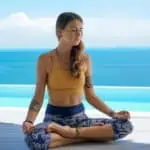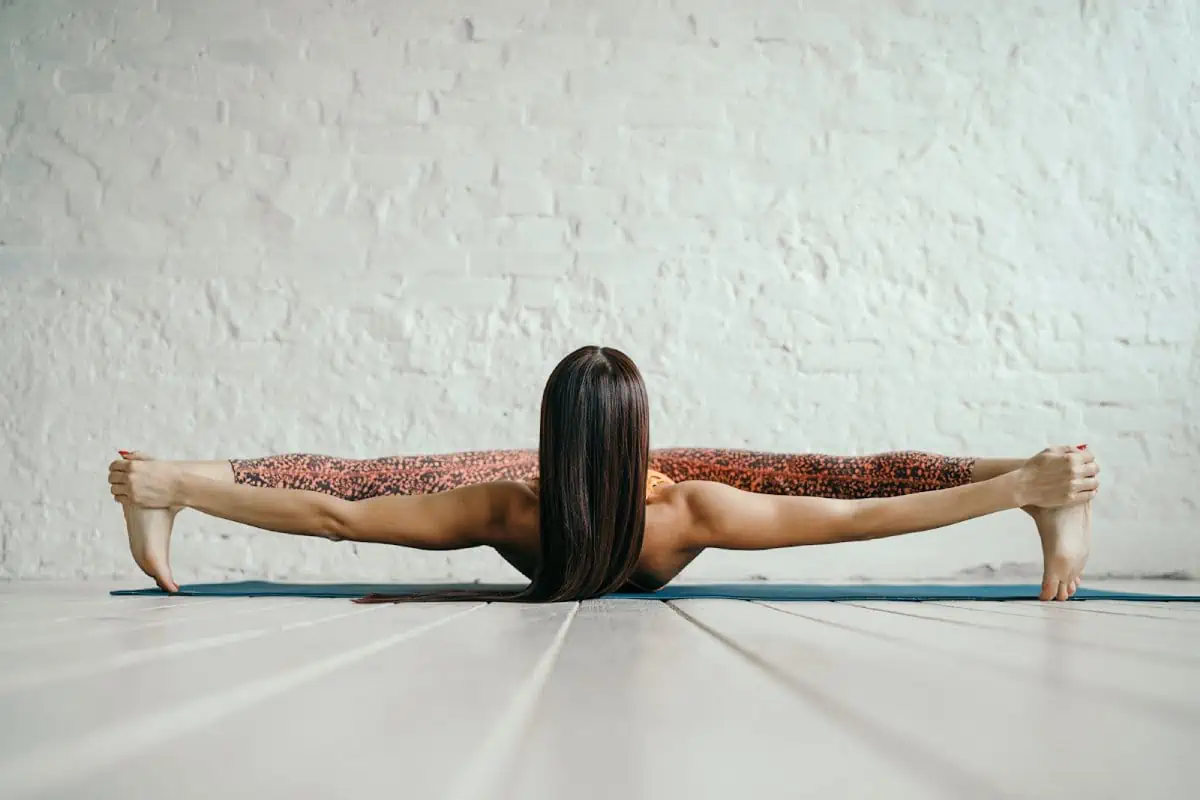Key Takeaway
Discover 20 transformative yoga poses that enhance flexibility across your spine, hips, legs, and shoulders, and learn how to integrate them into your routine for a more supple, pain-free body.
The ancient practice of yoga may have been created to enhance spiritual awareness and help Indian yogis reach enlightenment. But one of the most significant modern-day benefits is the increased flexibility that practicing these poses brings.
What’s more, in our highly sedentary lifestyle where we spend large chunks of time sitting at a desk, behind the wheel, or in front of the TV, never has improving flexibility been more vital.
Whether you’re struggling with tight hamstrings or hips or tension in your back or shoulders, yoga will help you become more supple and mobile. This, in turn, will hugely improve your health, quality of life, and even longevity.
Let’s explore the 20 best yoga stretches for flexibility, including the spine, hips, legs, and shoulders. And be sure to read to the end, as I’ll reveal my top tips for increasing flexibility fast with yoga.
Contents
Flexibility Poses For The Spine
Cat Cow Pose
The cat-cow pose is a popular warm-up posture in any yoga practice as it stretches the back, opens the chest and torso, and improves spinal mobility. This makes it a perfect preparation for deeper back and forward bend stretches.
To do a cat-cow, start in a tabletop position with your wrists under your shoulders and your knees under your hips. Find a neutral spine, then arch the back and press the chest forward into a cow pose as you inhale. As you exhale, round the spine and tuck the chin to the chest in a cat pose.
Rather than holding these stretches, alternate between them for at least five rounds. Move with your breath, inhaling as you arch the back and exhaling as you round it.
Child’s Pose
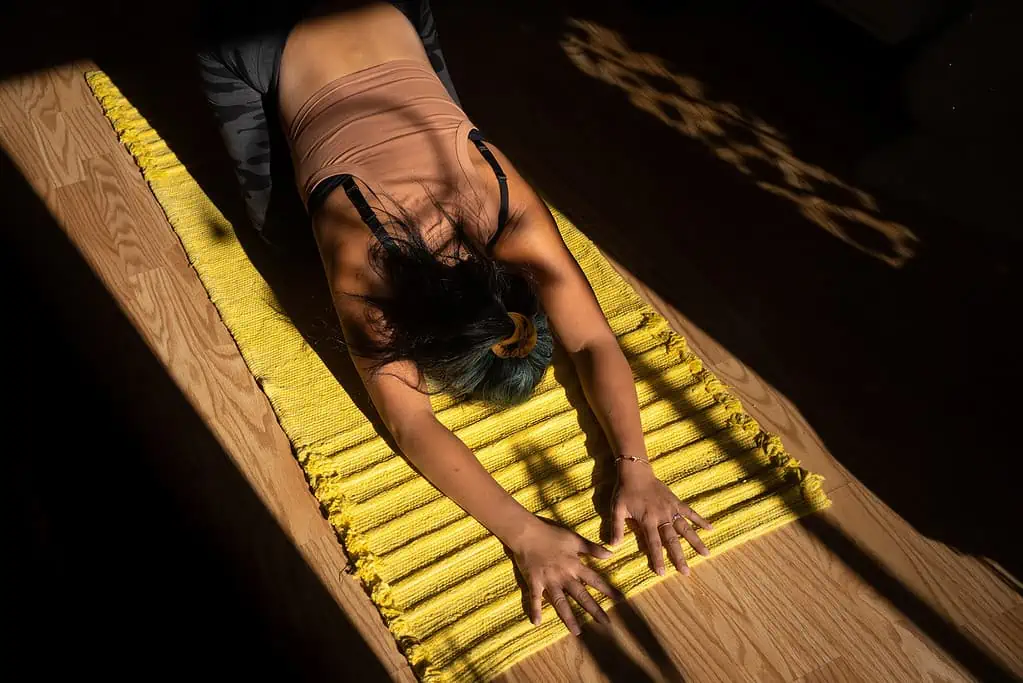
Child’s pose is an underrated asana. It is often practiced as a resting or cool-down pose but is excellent for improving flexibility in the back and preparing for more advanced poses. Moreover, doing the wide knee variation adds a gentle stretch to the hip flexors.
Sit on your heels with your knees together. Fold over your thighs, releasing your arms in front of you. Rest the forehead on the ground or a block. For an active, deeper stretch in the spine, walk your fingers as far forward as possible while pressing your hips back to your heels.
Bridge Pose
The reclined backbend Bridge pose stretches the spine, chest, torso, and neck while strengthening the back muscles and the glutes. In addition, it significantly helps to improve spinal mobility, preparing for more advanced poses like the wheel.
From a reclined position with the knees bent, walk your feet towards your hips and place them flat on the floor. Check that you can reach your heels with your fingertips.
Keeping the thighs together, inhale to push your feet into the ground and lift the hips. Next, engage your glutes and thighs to keep the hips lifted as you clasp your hands behind your back and draw the shoulder blades together.
Press the shoulders and upper arms into the ground as you lift the hips and hold for at least five breaths.
Plow Pose
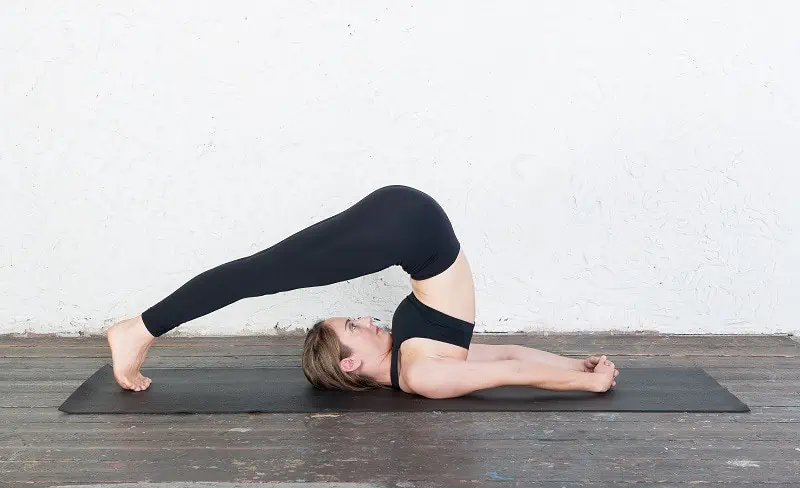
The plow pose is an inversion often included in the shoulder-stand sequence. However, this posture is also one of the best yoga poses for flexibility, helping to create a more supple spine.
The deep forward bend position improves muscle and joint mobility in the back and spine and relieves tightness and tension in the shoulders and back. However, note that as this is a deep stretch, this pose should be performed toward the end of the practice when the back is warm.
Lay on your back and bend your knees with your feet off the ground. Press your hands into the mat to lift the hips and extend the legs overhead. Bring your hands to your lower back and try to straighten the legs, bringing the toes to the floor behind you.
Standing Forward Bend
Standing forward bend is a typical posture found in the sun salutations and is often practiced between standing sequences. Practicing this pose will help create a strong, flexible spine and reduce tension or pain in the lower back. It also stretches the legs and hips and feels rejuvenating for the entire body.
From a standing position with the feet hip-distance apart, fold forward from the waist, lowering your head to the ground and your torso towards the thighs. Bring your hands to the floor or a block and relax the head and neck.
For a deeper spinal stretch, grab your big toes with your peace fingers and bend the elbows to the side. Keep your legs straight as you try to pull your torso and chest closer to your legs.
Flexibility Poses For The Hips
Pigeon Pose
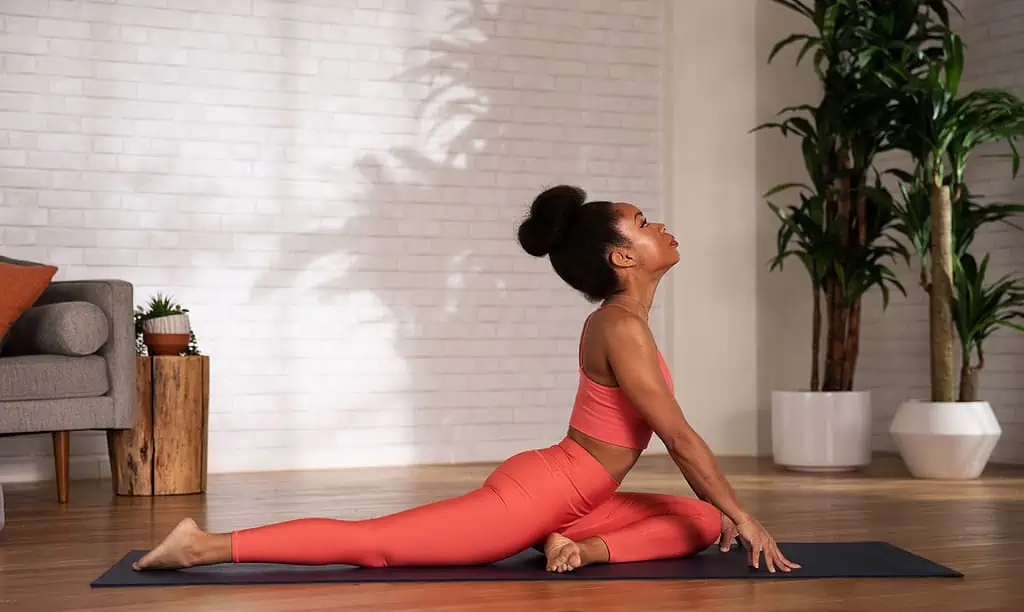
The pigeon pose targets the outer hip muscles, including the psoas and the piriformis. These muscles are commonly tight due to long periods of sitting; thus, this is a vital stretch for people who sit down during their jobs.
From a tabletop position, draw your right knee forward, placing it by your right wrist. Next, sink your hips and straighten your spine (place a folded blanket underneath the right hip if needed). Stay upright or fold your torso forward, coming down onto your forearms.
Lizard Pose
Lizard pose stretches the inner hip flexors and groin muscles. When combined with the pigeon, these two asanas improve the full range of motion in the hip region. Lizard also stretches the hamstrings and quadriceps and works the back extensors and lower back muscles.
Step your left foot forward from a tabletop position, placing it outside the left arm. Hug the knee to the left shoulder and either stay on your hands with the arms straight or bend the elbows to release the forearms to the floor or a block.
Frog Pose
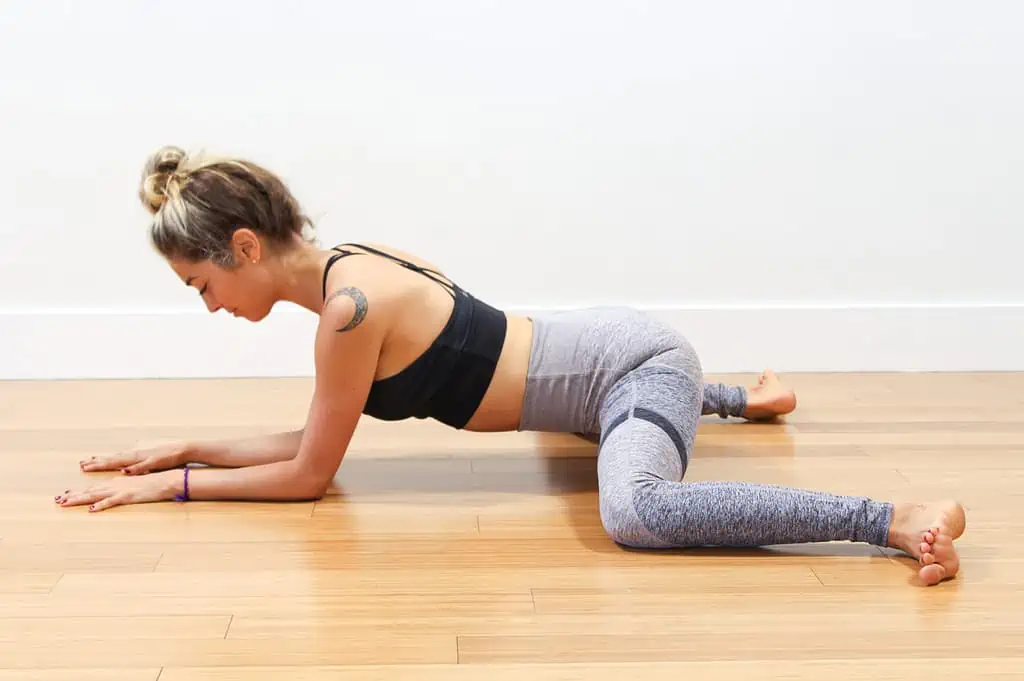
The frog pose is another great stretch for the inner hips, inner thighs, and groin, increasing the range of motion in tight hips. It also stretches the back muscles, helping to relieve pain there.
Start by sitting on your heels and opening your knees wide. Next, bend forward, place your hands on the ground, and lift your hips. Then, bring your feet out wide (in line with your knees) and lower your forearms to the floor, keeping your hips stacked over your knees.
Notice how it feels in the hips, and if you can go deeper, widen the knees and feet further.
Happy Baby Pose
The happy baby pose is one of the most accessible yoga poses for flexibility in the hip region. It stretches the inner hip flexors, groin, and thighs and is soothing for the back.
Lay down, bend your knees, and hug them to your chest. Grab the outside of both feet or the big toes, then open the knees wide (keeping them bent) and turn the soles up to the ceiling. Draw your knees down to your shoulders for a deeper stretch.
Splits Pose
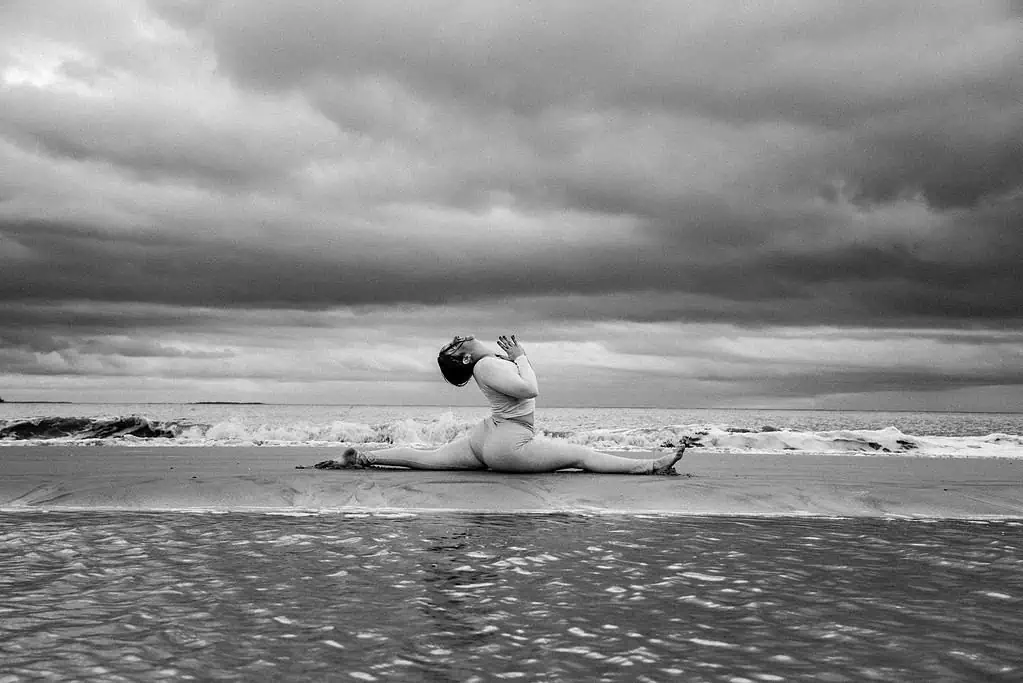
Splits pose (Hanumanasana) is one of the best but most challenging yoga poses for flexibility in the lower body. Be sure to only attempt this pose after doing many warm-up asanas that target the inner and outer hips and the quads and hamstrings (like those listed above).
As the split pose is not accessible for many people, I recommend first coming into the half split pose. Then, if you can go further, you can attempt to enter into the full variation.
Step your left foot forward in between your hands from a tabletop position. Press your hips back to straighten the left leg, and fold your torso over the thigh.
To go deeper:
- Walk your left foot further forward while extending your right foot behind you.
- Sink your hips as low as possible, then place a prop underneath to provide support.
- Sit upright with your hands on either side.
- Remember to try it on the opposite side too!
Flexibility Poses For The Legs
Downward-Facing Dog
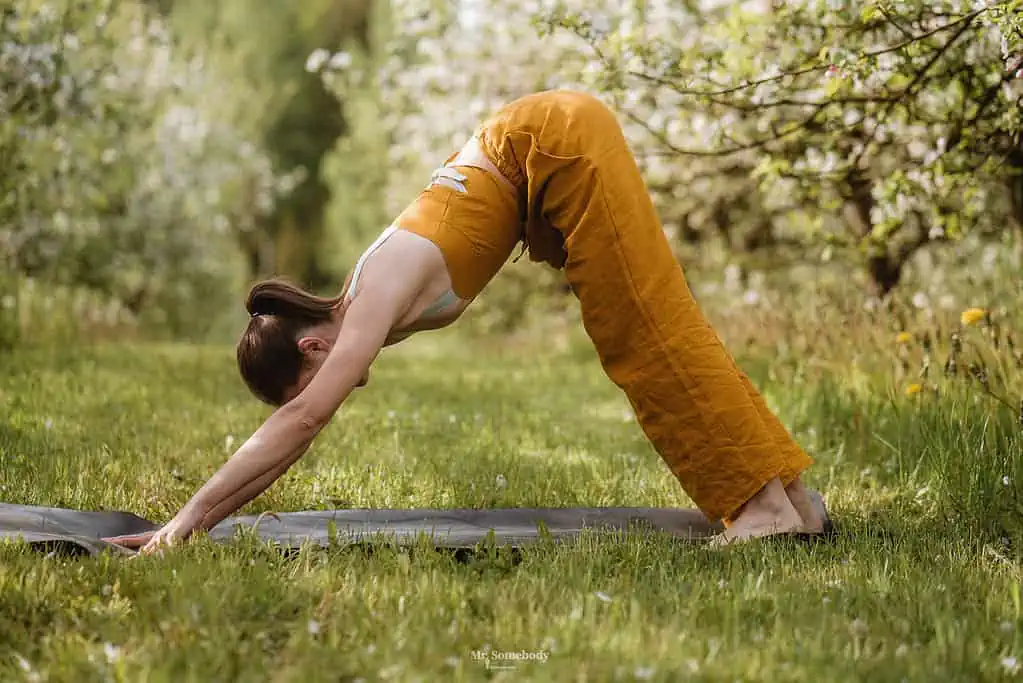
Although the downward-facing dog stretches the entire body and targets all the major muscle groups, it is particularly helpful for people with tight hamstrings or calves. Thus, doing this pose regularly will help to improve flexibility in the legs while simultaneously strengthening the lower body.
From a tabletop position, tuck your toes and press your hands firmly into the mat with your fingers spread. Engage your core muscles to lift your knees, then gently push your hips back as you straighten your legs.
If you have tight hamstrings, keep a slight knee bend, and don’t worry about pressing the feet flat on the floor. As you develop more flexibility, this will become easier.
As you hold the downward-facing dog, straighten the arms and press the chest to the thighs while keeping the hips up.
Pyramid Pose
The pyramid pose gives a deep stretch to the hamstrings but also improves spinal and hip flexibility.
From a standing position, step your right leg back and turn the toes out to 45 degrees. Ensure your hips are facing forward, and keep the left knee straight. Next, bring your hands to your hips and press firmly through the heel of the right foot.
On an exhale, tilt from your hips to fold over your front leg. Release your hands to the floor or two blocks on either side of the front foot. Relax your head and neck; with each breath, try to move your chest closer to the leg.
For an additional stretch to the calf and Achilles, lift your front toes and flex them towards you. After 5 to 10 breaths, release and repeat on the right leg.
Head-to-Knee Pose (Janu Sirsasana)
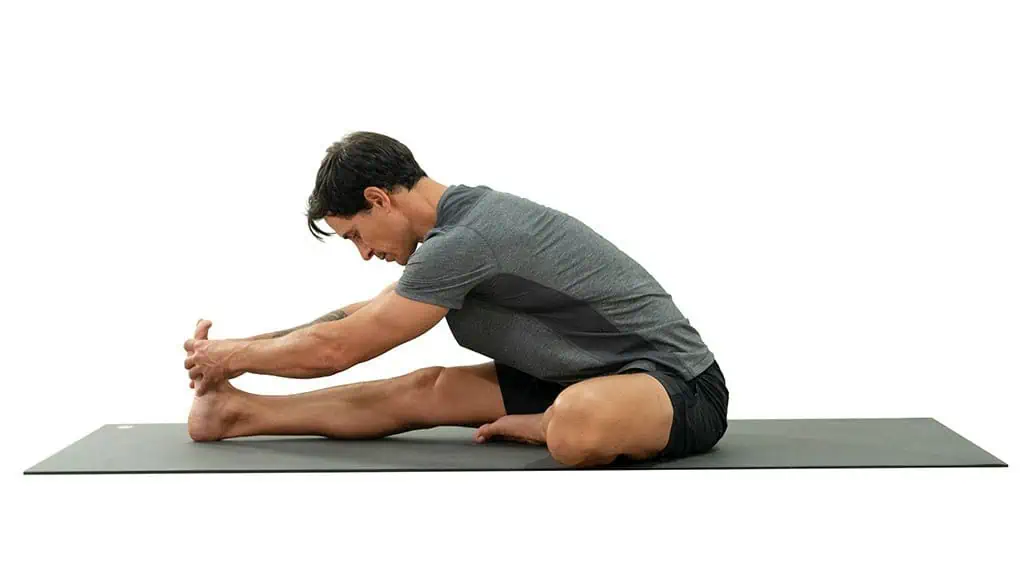
The head-to-knee pose is a seated forward fold where one leg is straight and the other is bent with the knee out to the side. This posture stretches the hamstring and calf of the extended leg while opening the other hip.
From a seated position with the legs extended, bend your left knee and place the foot on the inner right thigh. Allow the knee to drop out to the side. Sit up tall, and as you inhale, reach your arms overhead. As you exhale, tilt forward from the hips and slowly lower down, keeping the arms in line with the ears.
Release the hands to your right foot or leg and relax your head. If you can reach the foot, gently pull your chest towards it to deepen the hamstring stretch further.
Triangle Pose
The triangle pose is another multi-beneficial standing asana. It strengthens and lengthens the hamstrings and groin while opening the shoulders and chest and stretching the hip muscles. It also gives a reasonably intense side stretch.
Step the right foot back from standing and turn it out to 90 degrees, opening the hips to the side. Bring your arms out to shoulder height, and reach your left arm forward on an inhale like someone is pulling on your hand.
Lower the left hand to the left ankle, calf, or a yoga block and reach the right arm to the sky. Draw the top shoulder back to open the chest and look up.
Reclined Big Toe Pose
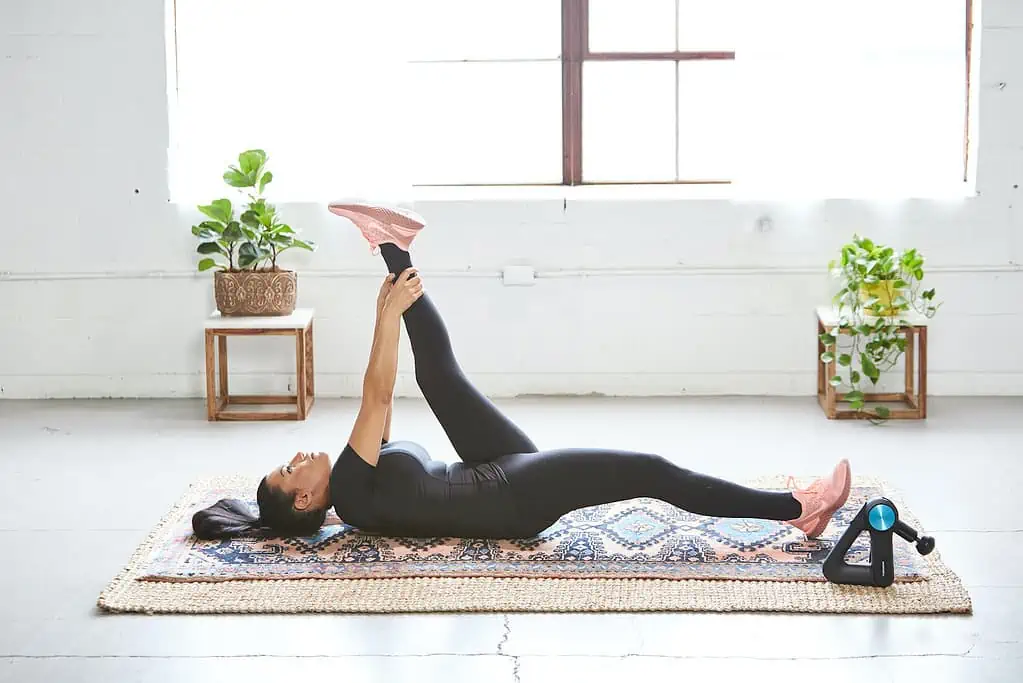
The reclined big-toe pose is one of my favorite stretches and my go-to asana after a long run! It stretches the entire back of the legs along with the inner thighs and lumber spine.
Laying on your back, bend your left knee towards you, clasping your hands around the back of the thigh. Straighten the leg, then gently draw the thigh towards you to extend it to 90 degrees.
For those with more leg flexibility, walk your hands up to the back of the calf or ankle and draw the leg closer to you. However, keep your back and shoulders on the ground as you do so.
Flexibility Poses For The Upper Body
Puppy Pose
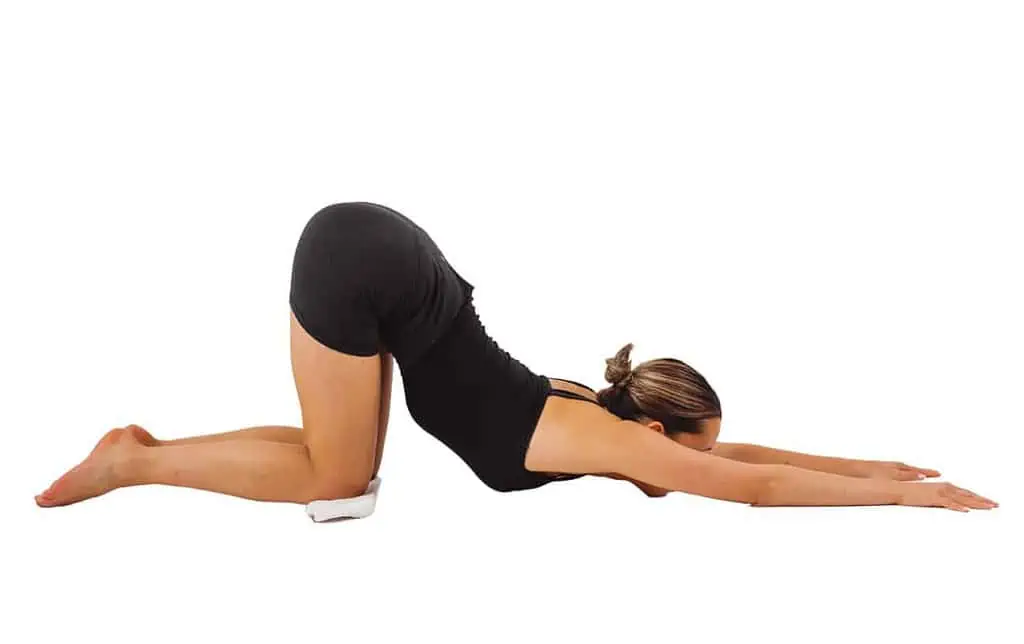
The puppy pose (also known as the heart-melting pose) opens up the entire upper body, including the shoulders, upper back, and arms. It also stretches the torso and abdominal muscles and creates a gentle backbend, easing tension in the lumbar spine.
From a tabletop position, walk your hands forward and sink your chest towards the mat. Bend your elbows to come onto your forearms and rest the forehead on the ground or a folded blanket.
Ensure your hips stay stacked over your knees, and take deep breaths here, trying to lower your chest a little bit further with each exhale. Option to bring your hands to the prayer position over the back of your head for a deeper shoulder opening.
Thread The Needle Pose
The “thread the needle” is a great pose for opening and stretching the shoulders, easing tightness and muscle tension while improving mobility in the thoracic spine.
From the tabletop position, extend your right arm up on an inhale. As you exhale, thread it under your left arm, lowering the right shoulder and side of the head to the ground (gaze to the left). Then, either walk your left hand forward to extend the arm or wrap it behind your back for a deeper stretch.
Cow-Face Pose
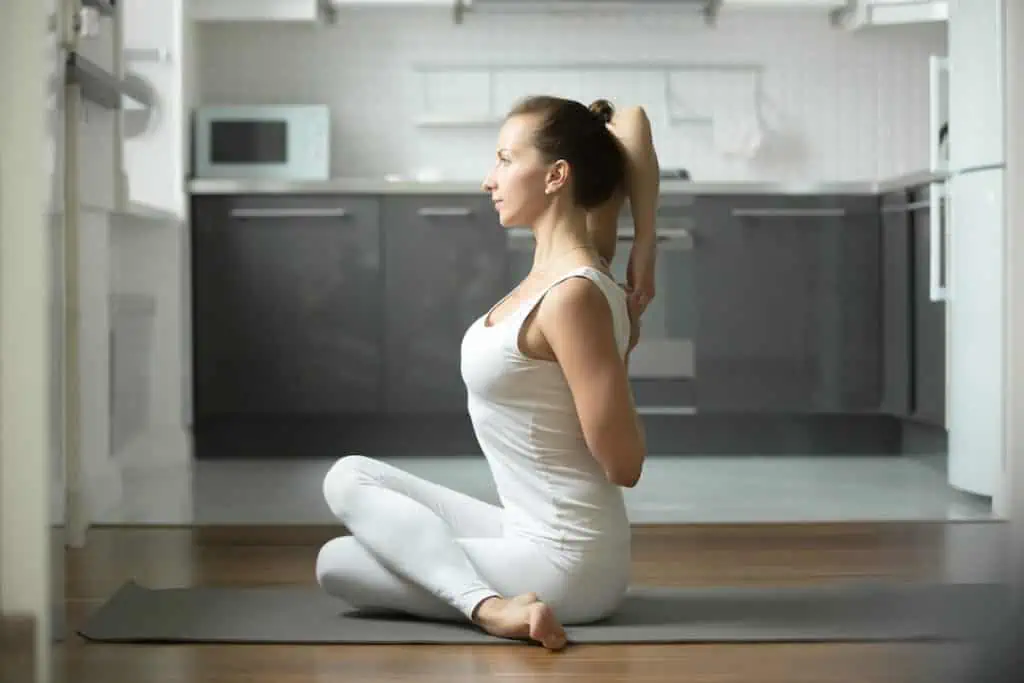
The cow face pose gives a deep stretch to the chest, shoulders, and arms, including the triceps and latissimus dorsi. When practiced with the legs crossed, it also stretches the hips, glutes, and outer thighs.
From a comfortable seated position, bend the right knee and place it above the left. Keep the bottom leg extended or bend the knee so both feet are close to the opposite hip.
Next, reach your right arm overhead and bend the elbow, bringing the fingers to the middle of the upper back. Then bend the left elbow, bringing the hand to the middle back, and try to clasp your hands. If this is too difficult, use a yoga strap to clasp instead.
Keep your spine straight, point your right elbow up to the sky, and breathe deeply. After 5 or so breaths, switch legs and change the arm grip.
Bow Pose
Bow pose creates a deep opening for the chest and shoulders while improving spinal mobility and stretching the quads.
From a prone position, bend both knees and grab your ankles. As you inhale, draw your shoulders back and press your hip bones into the mat to lift your chest and shoulders off the ground. Then kick your feet into your hands to lift the thighs and find more height and opening in the upper body.
Wheel Pose
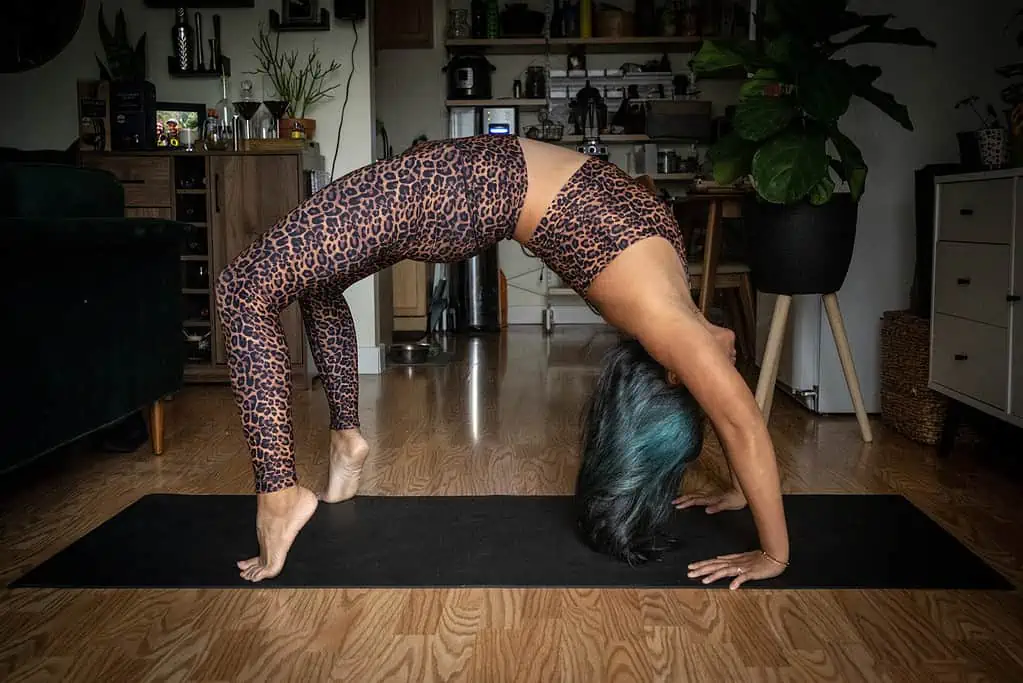
Wheel pose is one of the most advanced backbends in yoga, requiring good spinal mobility and open shoulders. Thus, this heart-opening yoga pose is challenging if you have tight shoulders, so be sure to only attempt it after the previous asanas and do Bridge as a prep pose.
Bend your knees and bring your feet to your hips in a reclined position. Next, bend your elbows and place your hands next to your ears with your fingertips facing your shoulders.
Engage the core as you press into your feet, lift the hips, and extend the arms. As your head comes off the ground, relax your neck and push your chest behind you.
Tips For Improving Flexibility In Yoga
Practice Regularly
Regular yoga practice is the key to improving flexibility. If you only practice yoga once a week, it will be a while before you see any progress.
Practicing yoga every day is fine; in fact, this is ideal for improving flexibility. However, if your schedule does not allow for daily practice, aim for at least three sessions per week. They do not have to be hour-long yoga classes; a 20–30 minute practice is sufficient.
I also recommend alternating between three or so yoga routines for flexibility so that you are not always doing the same postures. You can include different yoga poses for all body parts in each session. Or, if you prefer, focus one session on stretching the back, one on the hips and legs, and the other on the upper body.
If you need more inspiration for your yoga routines, you can find tons of yoga for flexibility videos on YouTube. You can search based on the length of practice you prefer or the area of the body you want to focus on. For example, this Yoga for Hips and Lower Back Release sequence from Yoga by Adriene is ideal if you have tight hips or back pain.
Use Props
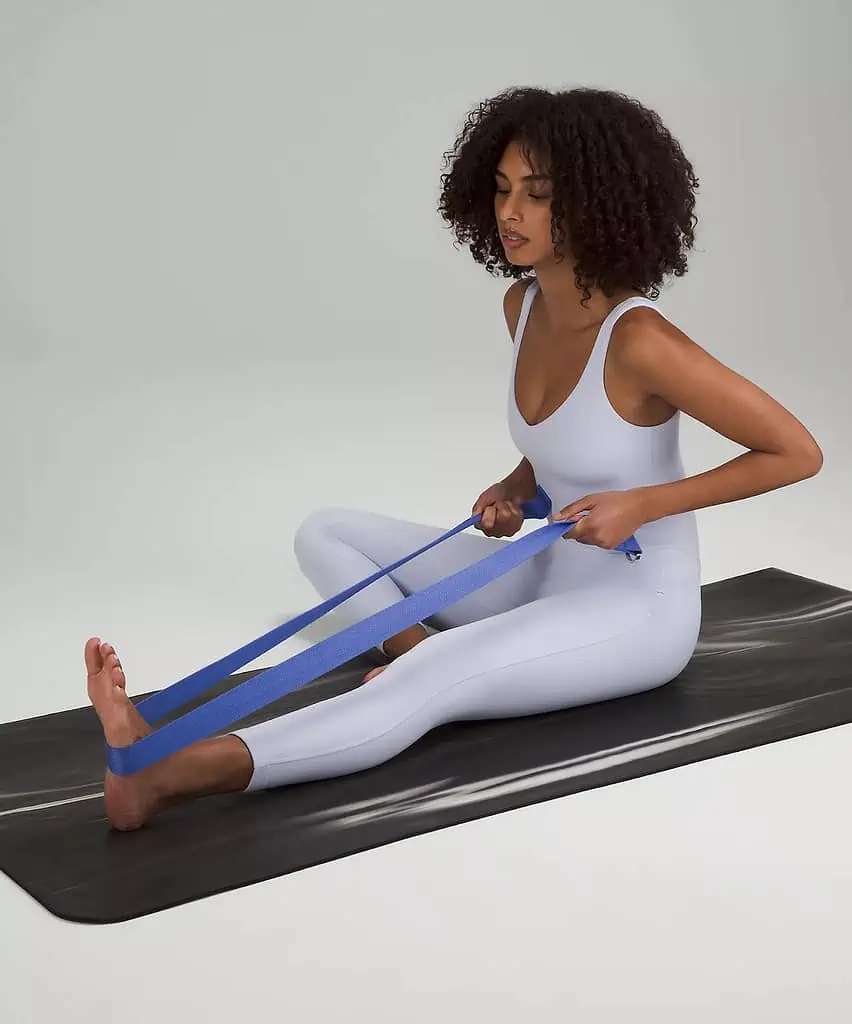
Aside from practicing regularly, I recommend using props. Yoga straps like the lululemon No Limits Strap are great for working with flexibility. Here are two examples of how to use them:
- To improve shoulder mobility: Hold the strap in both hands in front of you (hands wider than shoulder width). Pull the strap up and back as you inhale, moving past your head. Widen your grip on the strap as needed. Pull the strap back up and down to the starting position as you exhale. Do this at least 5 times.
- To stretch tight hamstrings: Use a strap in the Reclined Big Toe Pose. Place the strap around the middle of the sole and walk your hands up the strap until your head and shoulders are comfortably on the ground. Slowly extend your leg to 90 degrees or as far as you can, keeping it as straight as possible. For an added hip stretch, you can open the leg to the side while holding the strap in one hand.
I also recommend using a yoga wheel if you want to improve spinal mobility and go deeper into backbends. There are many ways to use them, such as a supported prop in Fish Pose or as an aid to prepare for advanced poses like Forearm Wheel.
You can also get sets of different-sized yoga wheels to support you as you progress in your yoga journey. For example, the UpCircleSeven 3-PackYoga Wheel Set contains 6, 10, and 12-inch wheels, so you can upgrade the size as you become more flexible. The wheels are also incredibly durable, holding up to 550 lbs, so you can trust them to fully support your weight.
Practice Yin Yoga
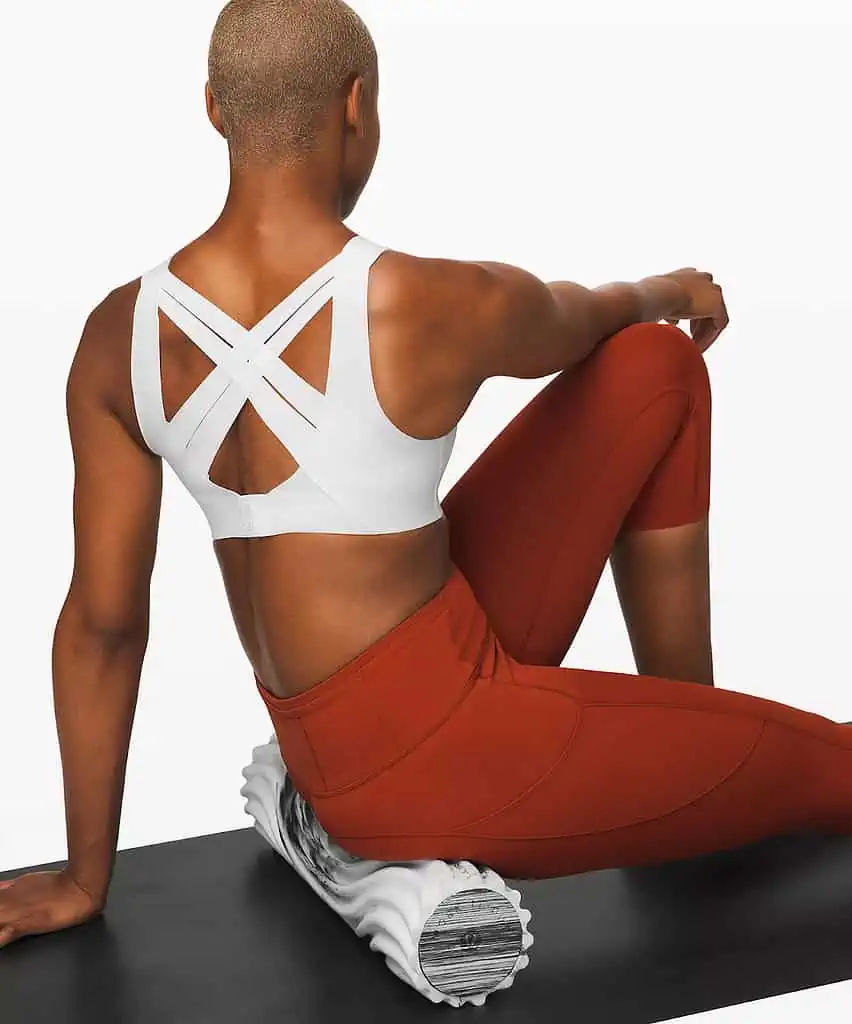
It’s important to understand that flexibility is not purely related to our muscles. The condition of our deeper connective tissues, like tendons, ligaments, and fascia, also determines how flexible we are.
Because of this, I always recommend that yogis combine yin yoga with more traditional styles like Hatha. In yin yoga, all the poses are held for extended periods (2 to 5 minutes per pose) to access and stretch those deeper connective tissues.
If you practice yin yoga regularly in addition to your usual yoga practice, you will likely notice you can go deeper into your favorite Hatha yoga poses. Plus, many of the Hatha flexibility yoga poses listed above (such as pigeon and lizard) can be practiced as yin poses by holding the stretches longer and more passively.
Another way to improve flexibility is by using a foam roller. Foam rolling breaks up knots in the muscles and fascia and helps create smoother muscle contractions. I love lululemon’s Double Roller, as the external roller massages your arms and legs while the interior helps release tension in the back.
Final Thoughts On Yoga Stretches For Flexibility
No matter how fit or healthy we may be, most of us experience tightness in one area of our body. These flexible yoga poses will help you release tension, prevent pain, and enjoy a greater range of motion in your day-to-day activities.

